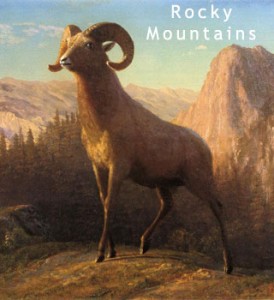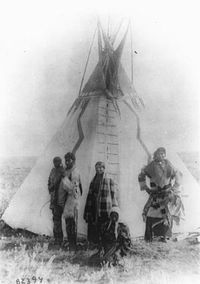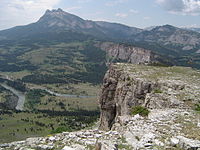Montana
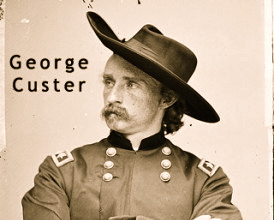
C-SPAN Cities Tour – Helena: Nicholas Vrooman “The Whole Country Was…One Robe”
Learn about the history of the Little Shell Tribe of Chippewa Indians of Montana and their struggle to become a federally recognized tribe from historian Nicholas Vrooman.
- (1743) Pierre De la Verendyre discovered Rocky Mountains
- (1795) Yellowstone River named by James Mackay
1800’s
- (1803) U. S. acquired most of Montana in Louisiana Purchase
- (1807) Manuel Lisa built first fur fort on Yellowstone River
- (1832) First steam boat arrived at Fort Union
- (1841) Father Pierre Jean de Smer established St. Mary’s Mission in Bitterroot Valley
- (1846) U. S. acquired the balance of Montana in Oregon Treaty
- (1862) Gold discovered at Grasshopper Creek
- (1864) Montana declared official territory; Butte founded
- (1872) Yellowstone National Park created by Congress
 (1876) Lt. Col George Custer and 197 men annihilated at Battle of Little Bighorn
(1876) Lt. Col George Custer and 197 men annihilated at Battle of Little Bighorn- (1877) Indian wars ended in Montana; copper mining began in Butte
- (1880) Utah and Northern Railroad entered Montana
- (1889) Montana became 41st state
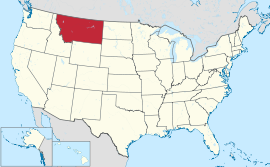 Montana (
Montana (![]() i/mɒnˈtænə/) is a state in the Western United States. The western third of Montana contains numerous mountain ranges. Smaller “island ranges” are found in the central third of the state, for a total of 77 named ranges that are part of the Rocky Mountains. This geographical fact is reflected in the state’s name, derived from the Spanish word montaña (mountain). Montana has several nicknames, none official, including: “Big Sky Country” and “The Treasure State”, and slogans that include “Land of the Shining Mountains” and more recently, “The Last Best Place”. Montana is the 4th-most extensive, but the 7th-least populous and the3rd-least densely populated of the 50 United States. The economy is primarily based on services, with ranching, wheat farming, oil and coal mining in the east, and lumber, tourism, and hard rock mining in the west. Millions of tourists annually visit Glacier National Park, the Little Bighorn Battlefield National Monument, and three of the five entrances to Yellowstone National Park.
i/mɒnˈtænə/) is a state in the Western United States. The western third of Montana contains numerous mountain ranges. Smaller “island ranges” are found in the central third of the state, for a total of 77 named ranges that are part of the Rocky Mountains. This geographical fact is reflected in the state’s name, derived from the Spanish word montaña (mountain). Montana has several nicknames, none official, including: “Big Sky Country” and “The Treasure State”, and slogans that include “Land of the Shining Mountains” and more recently, “The Last Best Place”. Montana is the 4th-most extensive, but the 7th-least populous and the3rd-least densely populated of the 50 United States. The economy is primarily based on services, with ranching, wheat farming, oil and coal mining in the east, and lumber, tourism, and hard rock mining in the west. Millions of tourists annually visit Glacier National Park, the Little Bighorn Battlefield National Monument, and three of the five entrances to Yellowstone National Park.
History
Assiniboine family, Montana, 1890–91
Various indigenous peoples lived in the territory of the present-day state of Montana for thousands of years. Historic tribes encountered by Europeans and settlers from the United States included the Crow in the south-central area; the Cheyenne in the southeast; the Blackfeet, Assiniboine and Gros Ventres in the central and north-central area; and theKootenai and Salish in the west. The smaller Pend d’Oreille and Kalispel tribes lived near Flathead Lake and the western mountains, respectively.
The land in Montana east of the continental divide was part of the Louisiana Purchase in 1803. Subsequent to the Lewis and Clark Expedition and after the finding of gold and copper (see the Copper Kings) in the area in the late 1850s, Montana became a United States territory (Montana Territory) on May 26, 1864. Prior to the creation of Montana Territory (1864–1889), various parts of what is now Montana were parts of Oregon Territory (1848–1859),Washington Territory (1853–1863), Idaho Territory (1863–1864), and Dakota Territory (1861–1864).
The Army established a series of posts in the late 1860s, including Fort Shaw, Camp Cooke on the Judith River and Fort C.F. Smith on the Bozeman Trail.
Montana was the scene of warfare as the Native Americans struggled to maintain control of their land. The Battle of the Little Bighorn was fought near the present-day town of Hardin. Montana was also the location of the final battles of the Nez Perce Wars.
The headwaters of the Sun River, just below Gibson Reservoir
A series of major mining discoveries in the western third of the state starting in 1862 found gold, silver, copper lead, coal (and later oil) that attracted tens of thousands of miners to the area. The richest of all gold placer diggings was discovered at Alder Gulch, where the town of Virginia City was established. Other rich placer deposits were found at Last Chance Gulch, where the city of Helena now stands, Confederate Gulch, Silver Bow, Emigrant Gulch, and Cooke City. Gold output from 1862 through 1876 reached $144 million; silver then became even more important. The largest mining operations were in the city of Butte, which had important silver deposits and gigantic copper deposits.
Cattle ranching has been central to Montana’s history and economy since the late-19th century. The Grant-Kohrs Ranch National Historic Site in Deer Lodge Valley is maintained as a link to the ranching style of the late 19th century. Operated by the National Park Service, it is a 1,900 acres (7.7 km2) working ranch.
The railroads arrived in the 1880s, including the Great Northern Railroad (1889) and its rival, the Northern Pacific Railroad (1883) from Minneapolis, and the Union Pacific Railroad (1881) from Denver. Montana railroading, with two transcontinentals to the Pacific coast and extensive operations to the mines, became a major industry, with centers in Billings and Havre. Montana became a state in 1889 in an omnibus package together with North Dakota, South Dakota and Washington. In 1888, Helena (the current state capital) had more millionaires per capita than any other city in the world.
The revised Homestead Act of 1909 greatly affected the settlement of Montana. This act expanded the amount of free land from 160 acres (0.6 km2) to 320 acres (1.3 km2) per family. Tens of thousands of inexperienced homesteaders arrived, lured by free land and high wheat prices, but they were unprepared for the climate, which usually had little rainfall and required special dry farming techniques. The droughts of 1917–1919 proved devastating, as many left, and half the banks in the state went bankrupt after providing mortgages that could not be repaid. The Great Depression caused further hardship for farmers and ranchers and miners, but the economy bounced back in the 1940s. The wheat farms in eastern Montana make the state a major producer; the wheat has a relatively high protein content and thus commands premium prices. After 1940 tourism became the state’s third largest industry with Yellowstone and Glacier national parks as the largest tourist attractions.
The planned battleship USS Montana was named in honor of the state. However, the battleship was never completed, making Montana the only one of the 48 states during World War II not to have a battleship named after it. Additionally, Alaska and Hawaii have both had nuclear submarines named after them. As such Montana is the only state in the union without a modern naval ship named in its honor. However, in August 2007 Senator Jon Tester made a request to the Navy that a submarine be christened USSMontana.
Politics in the state has been competitive, with the Democrats usually holding an edge, thanks to the support among unionized miners and railroad workers. Large scale battles revolved around the giant Anaconda Copper company, based in Butte and controlled by Rockefeller interests, until it closed in the 1970s. Until 1959, the company owned five of the state’s six largest newspapers.
American Indian reservations
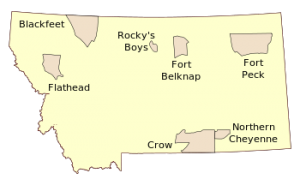 Seven Indian reservations in Montana (borders are not exact).
Seven Indian reservations in Montana (borders are not exact).
Seven American Indian reservations are located in Montana: Fort Peck Indian Reservation, Fort Belknap Indian Reservation, Northern Cheyenne Indian Reservation, Crow Indian Reservation, Rocky Boy’s Indian Reservation, Blackfeet Indian Reservation, and theFlathead Indian Reservation.
Cities and towns – List of cities and towns in Montana and List of counties in Montana
Montana has 56 counties with the United States Census Bureaustating Montana’s contains 364 “places”, broken down into 129incorporated places and 235 census-designated places. Incorporated places consist of 52 cities, 75 towns, and two consolidated city-counties. Montana has one city, Billings, with a population over 100,000; and two cities with populations over 50,000, Missoula and Great Falls. These three communities are considered the centers of Montana’s three Metropolitan Statistical Areas. The state also has five Micropolitan Statistical Areas centered on Bozeman, Butte, Helena, Kalispell and Havre.* These communities, excluding Havre, are colloquially known as the “big 7” Montana cities, as they are consistently the seven largest communities in Montana, with a significant population difference when these communities are compared to those that are 8th and lower on the list, and the only communities to host major airports. Based on 2000 census numbers, they collectively contain 34 percent of Montana’s population. and the counties containing these communities hold more than 60 percent of the state’s population.

